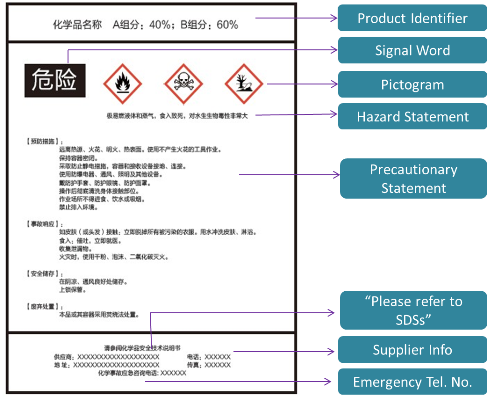GHS Implementation in China
Little Pro on 2015-12-30
China has fully implemented GHS for all hazardous substances and mixtures from 1 May 2011. Decree 591 requires manufacturers of hazardous chemicals to classify, label and package chemicals as well as prepare safety data sheets in accordance with relevant national standards. Decree 591 also prohibits distributors from selling hazardous chemicals without SDSs and labels. In addition, GHS SDSs and labels are required by new substance notification under MEP Order 7 and HazChem registration under SAWS Order 53.
Chemical classification criteria and the content and format of SDSs and labels are set by several compulsory national standards (prefixed with "GB") and recommended national standards (prefixed "GB/T") issued between 2008 and 2013. The table below summarizes the latest Chinese national standards that businesses need to follow to classify chemicals and prepare SDSs and labels.
| Classification |
|
| GHS Labelling |
|
| Safety Data Sheets | |
Critical Dates of GHS Implementation in China
| Substance |
|
| Mixture |
|
Classification Standards & Building Blocks in China
In 2013, the Standardization Administration of the People's Republic of China (SAC) issued 28 compulsory chemical classification standards (GB 30000.2-2013 to GB 30000.29-2013 Safety rules for classification and labelling of chemicals) and each standard corresponds to one hazard class under GHS. Those standards are fully aligned with UN GHS Rev. 4 and have adopted all building blocks under UN GHS Rev. 4 including aspiration hazards and hazards to the ozone layer.
For those who are interested in knowing chemical classification criteria in China, they may directly refer to the English version of UN GHS Rev. 4 since GB 30000.2~29 are directly translated from UN GHS Rev. 4.
Compulsory GHS Classification in China
For chemicals listed in the Catalogue of Hazardous Chemicals, the State Administration of Work Safety (SAWS) has published harmonized chemical classifications of those chemicals.Industry must use the classifications given in the guidance or more severe ones to classify their chemicals and prepare SDSs and labels.
Requirements on Chinese GHS Labels
GB 15258-2009 General rules for preparation of precautionary label for chemicals has set detailed requirements on the content and format of chemical labels. China has adopted standard GHS label elements (see example given below) and set additional requirements on language, 24h emergency telephone number, and sizes, etc.

- Language: simplified Chinese; ;
- Chemical identification: in both Chinese and English;
- Display of hazard statements: physical hazards must be displayed first followed by health hazards and environmental hazards;
- Domestic 24h emergency telephone number: required for imported hazardous chemicals;
- Small packages (<=100ml): precautionary statements can be omitted;
- Border color of a pictogram: black only allowed for chemicals for domestic use;
- Pictogram size: not specified; must be visible from a distance;
- Label size: depending on package capacity( please refer to the table below);

For workplace labelling, companies shall refer to GB 30000.30-201x (draft version available). For labelling of consumer products, companies shall refer to a separate standard called "risk-based GHS labelling of consumer product" which is also being drafted by SAC.
Safety Data Sheets (SDSs)
There are two important standards specifying the content and format of SDSs in China: GB/T 16483-2008 safety data sheet for chemical products: content and order of sections issued in 2008 and GB/T 17519-2013 Guidance on the compilation of safety data sheet for chemical products issued in 2013. GB/T 16483-2008 specifies the basic content and order of sections in Chinese SDSs while GB/T 17519-2013 provides detailed guidelines on how each section should be compiled in China.
- Standard 16 section GHS-format SDSs;
- Product identification: Consistent with names on label;
- Composition information: Hazardous ingredients displayed in a descending order based on concentration or concentration ranges;
- 24h emergency telephone number: Required;
- Language: Must be prepared in simplified Chinese.
Information Disclosure on Labels and in SDSs
Both GB 15258-2009 and GB/T 17519-2013 have given clear guidance on information disclosure on labels and in SDSs. Hazardous ingredients contributing to the classification of a substance or mixture and their concentration or concentration ranges shall be disclosed. Generic names are acceptable.
For trade secret ingredients, real substance names and CAS numbers can be hidden. However, hazards shall be fully disclosed.
Reference & Resources
Click here to access all references and resources for China including the English translation of regulations, regulatory lists, national standards and useful links to the websites of competent authorities.
Recommended Reading
- Global GHS Implementation
- GHS label size requirements;
- GHS and confidential business info;
- GHS and pesticides;
- GHS classification list;
- GHS classification criteria in a single page;
- GHS regulations and standards;
- GHS label for small containers;
- Correlations between GHS and TDG
- Comparison of GHS building blocks in EU, USA, China and Japan
Having Questions?
We do not provide consultancy services. If you have questions or need any help, please contact our sponsor. You may also find an expert in CSP business directory below. If you are a consultant, you may get yourself listed in CSP business directory (free) or sponsor this page to leave your contact info on this page..

Tags: Topics - China, GHS Implementation